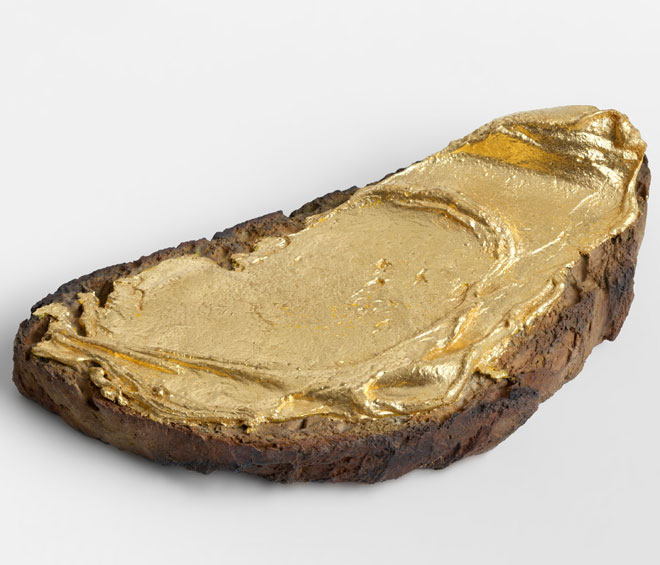
by VERONICA SIMPSON
On entering Hauser & Wirth’s London gallery, I have to leap swiftly to the left to avoid being mown down by two curatorial assistants wheeling a large painting around on a wooden trolley. Manoeuvring this huge, unwieldy contraption around corners is a hazardous procedure, and especially difficult to negotiate in a room full of people. But it is one of the multiple “difficult” elements that Martin Creed has choreographed for his new show, Toast. The painting in question is repeatedly wheeled into and out of the gallery, mounted on and then removed from a wall that otherwise screens Creed’s short video pieces.
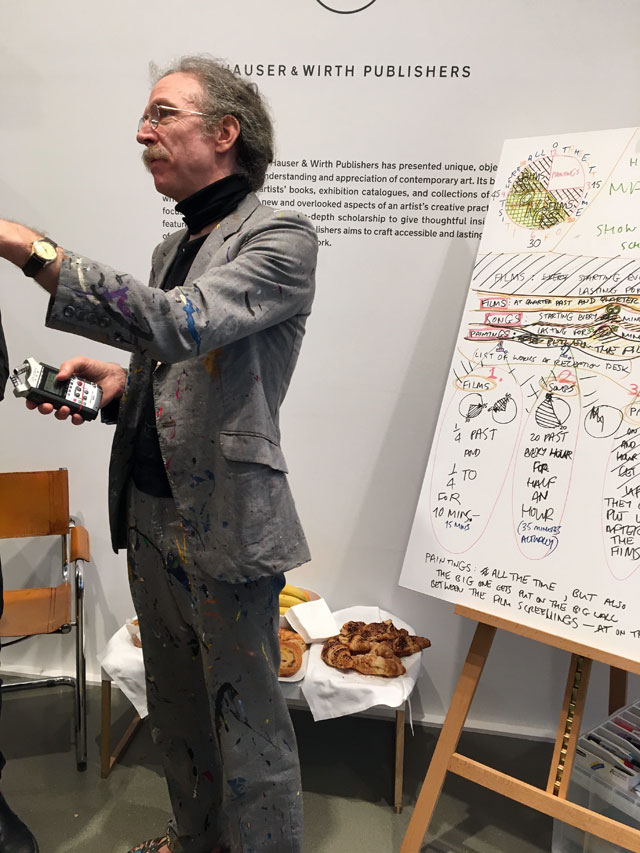
Martin Creed with sound recorder and choreography instructions, Hauser & Wirth, London, 2018. Photo: Veronica Simpson.
Other elements include an assortment of strolling, female minstrels in knitted bobble hats, who at different points enter collectively or singly to perform new pieces written specially for this show by Creed, before filing silently out again. As to the music, there are moments of joyous-sounding choral carolling, but the words are far from exultant. In typical Creed style, the singers are mostly expressing an internal angst that is both Creed-ian and universal. At one point, there is a singer lying on the floor intoning: “I’m not doing what I want to do”; another time, a singer slowly unfolds the sentence “Try to forget” in disjointed clusters. And there is an extended, sung monologue about “lying awake with difficult thoughts”, the phrase “difficult thoughts” being repeated in a looping pattern in a variety of contexts (“having a drink with …”, “having to live with …”).
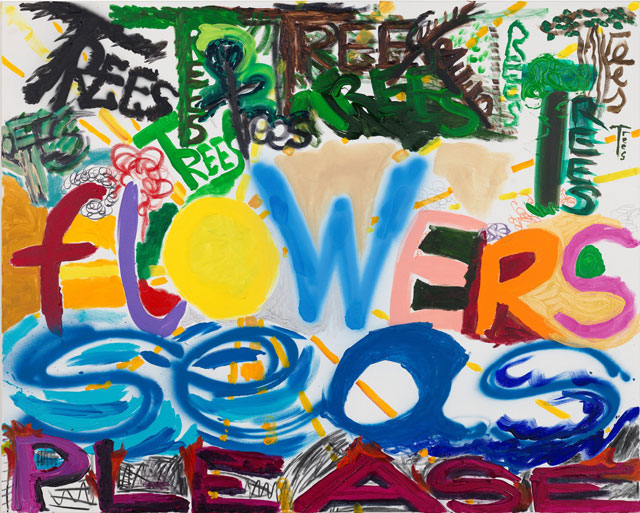
Martin Creed. Work No. 3113, TREES FLOWERS SEAS PLEASE, 2018. Acrylic, charcoal, graphite and oil on canvas, 152.7 x 122 x 2 cm (60 1/8 x 48 x 3/4 in). © Martin Creed. All Rights Reserved, DACS 2018. Courtesy the artist and Hauser & Wirth.
The music, Creed tells me, is inspired by a compositional technique called phasing, where a musical phrase played on two or more instruments is repeated in steady but not identical rhythms. In fact, this whole show’s performative programme appears to be a giant phasing experiment. Not just in the careful layering of film and movement and song (the instructions for which are laid out in a felt-penned planogram at the entrance to the show). But motifs – both images and words – crop up repeatedly in paintings, drawings and ink works. Bridges, water, flames, guns and suns occur frequently in a series of new, crisply graphic works, using acrylic, ink and paper. Elsewhere, the word “please” is stacked in piles on a dish in one drawn work, squished at the bottom of a painting in another, or dismembered and stacked loosely in a pile of letters in the work Please Help Me (2018). The title of one of the songs - There’s This and Then There’s This (Work No 3151) – is repeated as a line in one of his drawings (Work No 3041, 2018). The cumulative visual and verbal, repetitive cacophony is - I would imagine - wonderfully expressive of anxiety’s insistent, oppressively looping rhythms.
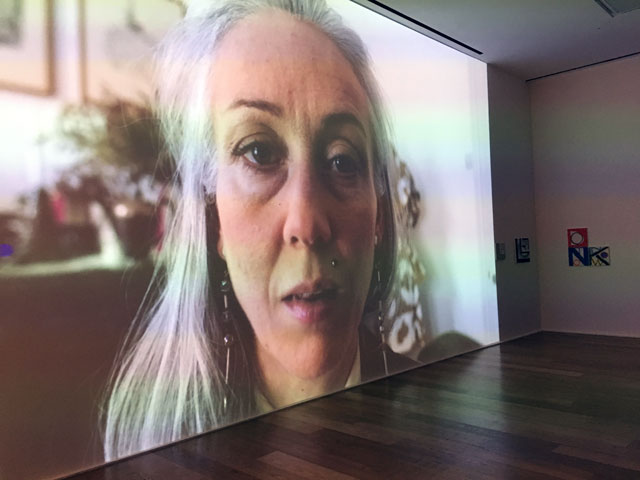
Martin Creed. Work No. 2724. Anouchka Grose Mouth CLOSED, installation view, Hauser & Wirth, London, 2018. Photo: Veronica Simpson.
Creed is open about his struggles with anxiety and depression. This show, he says, comes after a period when: “I was really depressed and sick of it all.” But one senses in this show a return to form, a return to the joy of making work, not least because he is present and sociable at the show’s opening. Wearing a paint-spattered grey suit and open-toed sandals despite the miserable November weather, he chats with arts journalists, observes the performers, or crouches watchfully in front of one of his videos, and at all times he carries a chunky recording device in one hand, recording every second. When asked why, he says: “I feel I can’t know where the good bits are … you just have to try and do everything and then record as much as possible and keep all your shit (laughs). Because I always want to throw it away, because I think it’s all shit, so I try to fight against that. I keep it all and then see, because usually the things you think are good are not good … it’s like self-delusion is one of the most difficult problems of life. So … if you like to work well, you have to trick yourself to not go along with yourself, not trust yourself.”
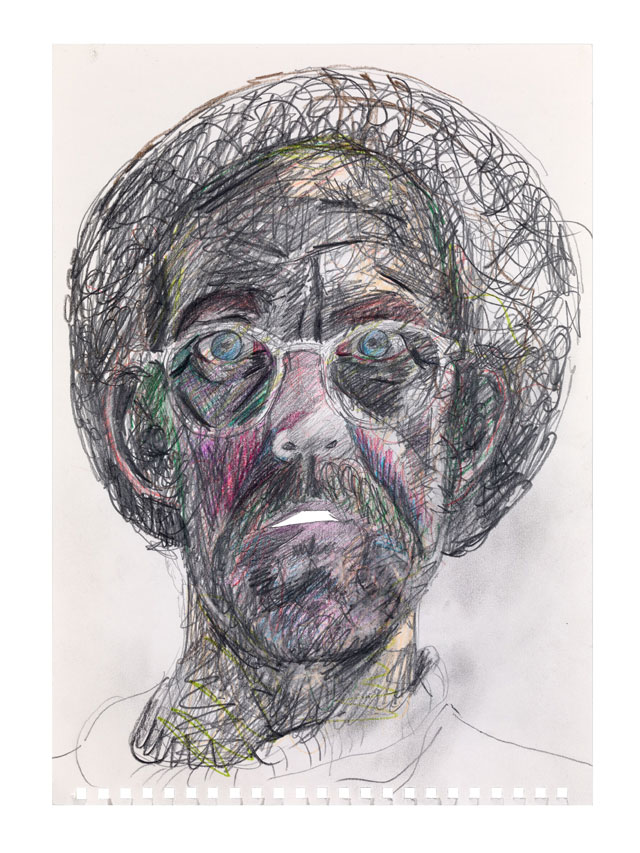
Martin Creed. Work No. 2965, Self portrait in a hair net with mouth open, 2014-18. Graphite and coloured pencil on paper, 29.7 x 21 cm (11 3/4 x 8 1/4 in). © Martin Creed. All Rights Reserved, DACS 2018. Courtesy the artist and Hauser & Wirth.
To live under this constant barrage of self-criticism sounds painful and incredibly hard work; would it be vacuous to suggest Creed enrol in a meditation or mindfulness course, or take up knitting? Perhaps he already has (there is a woollen work, Work No 2977, 2018). Mind you, to unravel those fizzing knots of anxiety – so beautifully articulated in the Self-Portrait in a Hair Net with Mouth Open (2014-18) – would undoubtedly alter the chemistry of Creed’s particular genius. For while that sense of grating unease permeates many of Creed’s pieces, there are also moments of the kind of sublime, hilarious bathos that Creed does so well – celebrating everyday items such as scrumpled balls of paper or blobs of Blu Tack, but placing them in a self-consciously artistic setting to poke fun at art-world pretentions. Here we have a plinth bearing a rotating piece of what looks like toast smeared with a buttery paste of pure gold. It’s actually called: Work No 3017, Peanut Butter On Toast (2018). There are also trademark pieces of pure clownish silliness – a grey sock jerking and dancing on a wire, controlled by a clunky mechanical contraption, Work No 3159, Dancing Sock (2018).
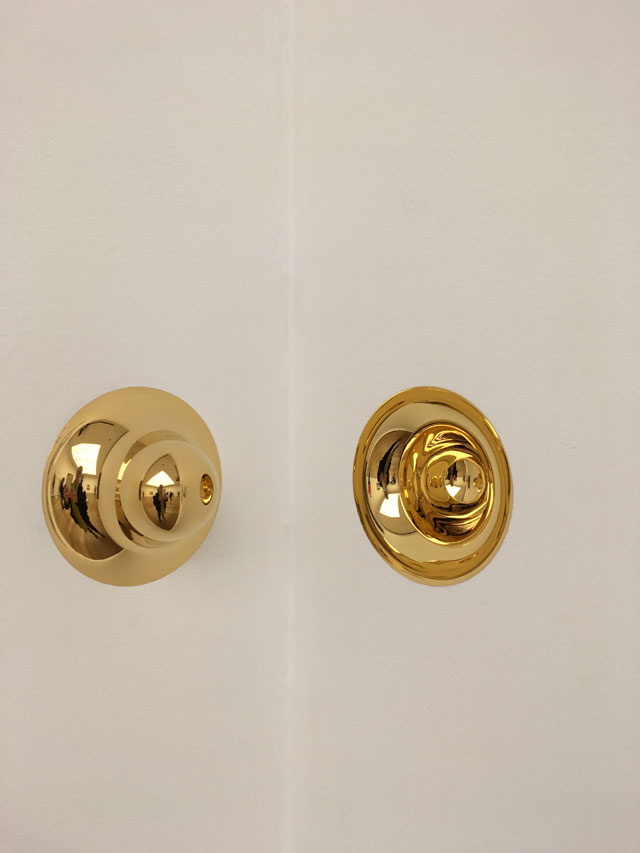
Martin Creed. Work No. 2957, An intrusion and a protrusion from a wall, installation view, Hauser & Wirth, London, 2018. Photo: Veronica Simpson.
When it comes to visual (and verbal) jokes, however, my favourite has to be the pair of golden breasts situated at chest height in one corner, one jutting into the room, while its concave, gilded replica is indented into the wall opposite (positioned so that, if these walls were pages in a book, and the book was closed they would fold into each other). With deadpan wit, Creed has titled this work (Work No 2957): An Intrusion and a Protrusion from a Wall (2018).
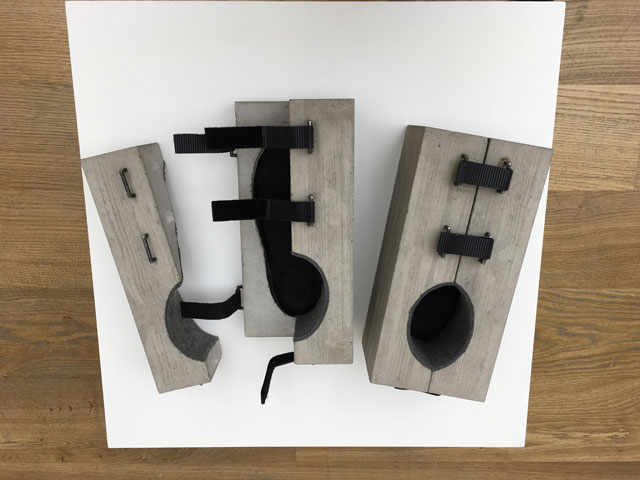
Martin Creed. Work No. 3088, 2018. Concrete, felt, steel, velcro. Installation view, Hauser & Wirth, London, 2018. Photo: Veronica Simpson.
There are so many works in this one gallery, multiple drawings, paintings, sculptures; even a strange pair of oblong, brick-like concrete shoes (Work No 3088). With such a multitude of fiercely or frantically expressed attitudes and emotions all crammed into one room, it could be chaotic, but there is something exhilarating in the cumulative, effervescent energy and the rainbow colourings.
Asked whether he is happy with the show, he answers instantly and emphatically: “No,” then laughs. “It has its moments. Because I’m just in a state of turmoil about it … I’ve got all my bad feelings going on. I’ve got no way of knowing how this went. Not to me anyway.” When pressed to say if there are any elements he’s happy with, he says: “Try to Forget – there was this song called Try to Forget. Those are all new bits, just wee bits. It’s all just bits. But those bits I especially like. Try to Forget was really good. And the other one was (the song) I’m Not Doing What I Want to Do, with the choir coming in: ‘We’re not doing what we want to do.’ I find this quite true to life.”
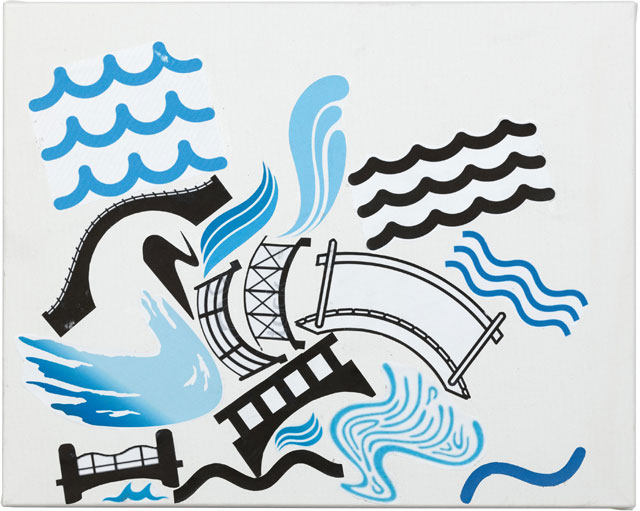
Martin Creed. Work No. 2971, Bridges under water, 2018. Ink and paper on canvas, 40.6 x 50.8 cm (16 x 20 in). © Martin Creed. All Rights Reserved, DACS 2018. Courtesy the artist and Hauser & Wirth.
While he talks a great deal about anxiety and struggle, there is so much comic dexterity in the show, which combines at times with the darkness in ways that are quite unsettling and profound. One instance is a series of short video portraits where he focuses on a single friend or family member (his mother is here, for example), as they stare serenely, impassively at the camera for up to a minute, and then slowly open their mouths to reveal half-chewed food. About this work, he says: “It just came from that thing at the kitchen table of just opening your mouth … to really gross people out. Which I really enjoy doing. I was doing it so much I thought that obviously it was very important to me. So, then I thought I’d make a film of it. When I thought of the idea of doing a thing of people opening their mouths, I just thought it was brilliant. Because I always feel horrible, you know. So, the gross opening your mouth is like … It’s an equivalent to showing your feelings. The biggest difficulty in life is you’re at the mercy of these feelings you don’t have any control over, they just come up. So your mouth with horrible stuff inside, that’s like feelings.”
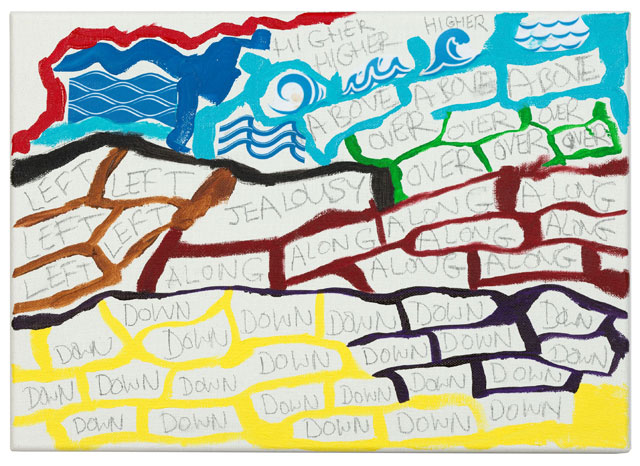
Martin Creed. Work No. 2966, 2018. Acrylic, graphite, ink and paper on canvas, 30 x 16.5 cm (11 3/4 x 6 1/2 in). © Martin Creed. All Rights Reserved, DACS 2018. Courtesy the artist and Hauser & Wirth.
But, I suggest, he must surely have a certain amount of fun developing these visual gags. He says: “I just like it when things make you happy or if it makes you laugh, like opening your mouth - that kind of stupid. It’s got to be stupid … When I say stupid, I don’t mean in a bad way, just not (in a way) that adds up on paper or makes sense. Because in the art world you can get drawn into that, even when you’re at art school … you have to develop all these defensive arguments to support your work … rather than just being a bit more free. That’s what I mean by stupid.”
So, perhaps the show is a celebration of stupid – of those moments where you have stopped caring what anyone thinks. If so, long live stupid.
• Martin Creed: Toast is at Hauser & Wirth, London, until 9 February 2019.